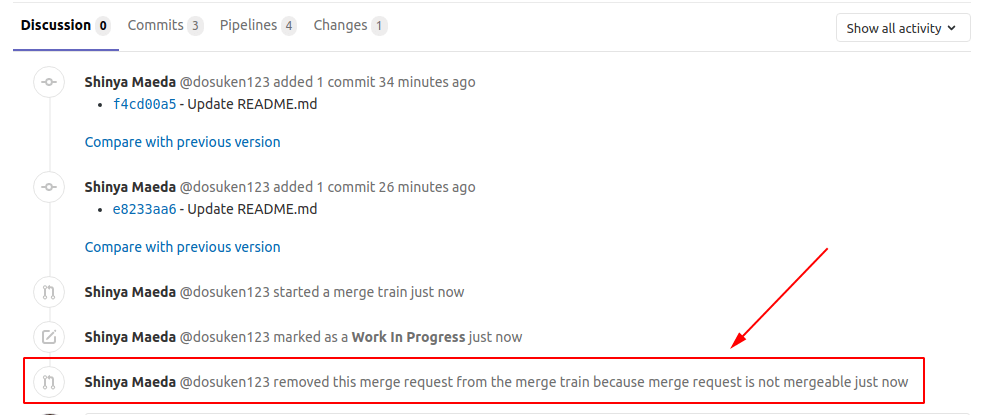Merge Trains (PREMIUM)
Introduced in GitLab Premium 12.0.
Pipelines for merged results introduces running a build on the result of the merged code prior to merging, as a way to keep master green.
There's a scenario, however, for teams with a high number of changes in the target branch (typically master) where in many or even all cases, by the time the merged code is validated another commit has made it to master, invalidating the merged result. You'd need some kind of queuing, cancellation or retry mechanism for these scenarios in order to ensure an orderly flow of changes into the target branch.
Each MR that joins a merge train joins as the last item in the train, just as it works in the current state. However, instead of queuing and waiting, each item takes the completed state of the previous (pending) merge ref, adds its own changes, and starts the pipeline immediately in parallel under the assumption that everything is going to pass.
In this way, if all the pipelines in the train merge successfully, no pipeline time is wasted either queuing or retrying. If the button is subsequently pressed in a different MR, instead of creating a new pipeline for the target branch, it creates a new pipeline targeting the merge result of the previous MR plus the target branch. Pipelines invalidated through failures are immediately canceled and requeued.
Requirements and limitations
Merge trains have the following requirements and limitations:
- This feature requires that pipelines for merged results are configured properly.
- Each merge train can run a maximum of four pipelines in parallel. If more than four merge requests are added to the merge train, the merge requests will be queued until a slot in the merge train is free. There is no limit to the number of merge requests that can be queued.
- This feature does not support squash and merge.
Watch this video for a demonstration on how parallel execution of Merge Trains can prevent commits from breaking the default branch.
How to add a merge request to a merge train
To add a merge request to a merge train:
- Visit a merge request.
- Click the Start/Add to merge train button.
How to remove a merge request from a merge train
- Visit a merge request.
- Click the Remove from merge train button.
How to view a merge request's current position on the merge train
After a merge request has been added to the merge train, the merge request's current position will be displayed under the pipeline widget:
Start/Add to merge train when pipeline succeeds
You can add a merge request to a merge train only when the latest pipeline in the merge request finished. While the pipeline is running or pending, you cannot add the merge request to a train because the current change of the merge request may be broken thus it could affect the following merge requests.
In this case, you can schedule to add the merge request to a merge train when the latest pipeline succeeds (This pipeline is Pipelines for merged results, not Pipelines for merge train). You can see the following button instead of the regular Start/Add to merge train button while the latest pipeline is running.
Immediately merge a merge request with a merge train
In case, you have a high-priority merge request (e.g. critical patch) to be merged urgently, you can use Merge Immediately option for bypassing the merge train. This is the fastest option to get the change merged into the target branch.
However, every time you merge a merge request immediately, it could affect the existing merge train to be reconstructed, specifically, it regenerates expected merge commits and pipelines. This means, merging immediately essentially wastes CI resources.
Troubleshooting
Merge request dropped from the merge train immediately
If a merge request is not mergeable (for example, it's WIP, there is a merge conflict, etc), your merge request will be dropped from the merge train automatically.
In these cases, the reason for dropping the merge request is in the system notes.
To check the reason:
- Open the merge request that was dropped from the merge train.
- Open the Discussion tab.
- Find a system note that includes either:
- The text ... removed this merge request from the merge train because ...
- ... aborted this merge request from the merge train because ... The reason is given in the text after the because ... phrase.
Merge When Pipeline Succeeds cannot be chosen
Merge When Pipeline Succeeds is unavailable when Pipelines for Merged Results is enabled.
Follow this issue to track progress on this issue.
Merge Train disturbs your workflow
First of all, please check if merge immediately is available as a workaround in your workflow. This is the most recommended workaround you'd be able to take immediately. If it's not available or acceptable, please read through this section.
Merge train is enabled by default when you enable Pipelines for merged results,
however, you can forcibly disable this feature by disabling the feature flag :merge_trains_enabled.
After you disabled this feature, all the existing merge trains will be aborted and
you will no longer see the Start/Add Merge Train button in merge requests.
To check if the feature flag is enabled on your GitLab instance, please ask administrator to execute the following commands:
> sudo gitlab-rails console # Login to Rails console of GitLab instance.
> Feature.enabled?(:merge_trains_enabled) # Check if it's enabled or not.
> Feature.disable(:merge_trains_enabled) # Disable the feature flag.




